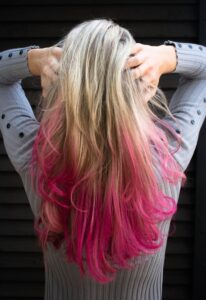Balayage vs Ombre The Ultimate Cosmetology Student Guide
As an aspiring colorist, you will find that few services are as highly requested—and as commonly confused—as balayage and ombré. Clients often use these terms interchangeably, but understanding the true distinction between balayage vs ombre is the mark of a skilled professional. The fundamental difference is this: Balayage is a technique, and ombré is an effect. Mastering this nuance is critical for setting client expectations, pricing services correctly, and achieving the stunning results that build a loyal clientele. This guide breaks down the essential differences in application, visual result, and maintenance to ensure you can confidently deliver either service.

Photo by Maria Geller on Pexels
The Science of Balayage (The “Sweep” Technique)
The term balayage comes from the French word meaning “to sweep.” It is a hand-painted highlighting technique that originated in French salons in the 1970s and is currently the most popular modern coloring method. It is favored for its ability to create a customized, sun-kissed, and incredibly low-maintenance look.
Application Method: Freehand, Vertical Painting, and Lift
Balayage is fundamentally a freehand method. Colorists use brushes and their hands, often skipping the use of foils entirely, to apply lightener only to the surface of the hair section.
- Vertical Strokes: The lightener is applied in long, sweeping, vertical motions. The application begins a few inches away from the root, is feathered softly upward, and is fully saturated toward the ends.
- Surface Saturation: Because the color is concentrated on the top layer of the hair and not fully saturated through the whole section (like traditional highlights), the lift is softer, and the grow-out is more natural.
- Custom Placement: The lightened pieces are strategically placed to highlight the hair’s natural movement and the areas where the sun would naturally hit. This ensures a multi-tonal, dimensional result.
- Foilayage: For clients with naturally dark hair who want a higher level of lift, stylists often use Foilayage. This hybrid technique uses the same hand-painted method as balayage but then wraps the painted sections in foil. The foil traps heat, accelerating the lightener’s process and allowing for maximum lift without losing the feathered, blended look.

Photo by cottonbro studio on Pexels
Visual Result: Subtle, Sun-Kissed Dimension and Soft Regrowth
The goal of the balayage technique is dimension, not transformation. A successful balayage maintains 80-90% of the client’s natural base color.
| Balayage Feature | Description |
|---|---|
| Contrast | Subtle. The color transition is seamless and soft, mimicking the effortless effect of sun-lightened hair. |
| Line of Demarcation | Minimal to non-existent. The blending at the mid-lengths prevents a harsh line as the color grows out. |
| Color Saturation | Dispersed and dimensional. You will still see the client’s natural color between the lightened strands, which is key to the “lived-in” look. |
Longevity and Cost: High Initial Price, Low Maintenance
Balayage is prized for being one of the most low-maintenance color services available.
- Longevity: Due to the soft grow-out, most clients can go 12 to 14 weeks (3 to 4 months) between full touch-up sessions. The color simply blends down the hair shaft gracefully.
- Cost: The initial service is often the most expensive highlighting option because it requires more artistry, time, and advanced training from the stylist. However, the lower frequency of required appointments means the long-term maintenance cost is significantly lower than that of traditional foil highlights.
Learn how to master these in-demand services in the Cameo College Hair Coloring Program.
The Dynamics of Ombré (The “Shade” Effect)
The French word ombré translates to “shade” or “shadow.” It is a color effect characterized by a dramatic, gradient transition from a darker root to lighter ends. While balayage is subtle dimension, ombré is a bold, two-toned statement.
Application Method: Horizontal Saturation and Precision
Ombré application is structured differently than balayage, focusing on creating a defined color block with a seamless blend in the middle.
- Horizontal Placement: The lightener is applied horizontally, typically starting at the mid-shaft and moving to full saturation at the ends.
- Full Saturation: Unlike balayage, the ends of the sections are often fully saturated with lightener to ensure a striking, uniform contrast. The goal is to eliminate the natural color on the bottom portion of the hair.
- Blending the Transition: A stylist must carefully blend the lightener upward toward the root to diffuse the line of demarcation. This is often achieved using the balayage technique itself, proving that balayage is a tool used to create the effect of ombré.
- Foils and Precision: Foils or plastic wrap are commonly used during ombré application to isolate the lightened ends and ensure a precise, clean lift for the lightest part of the gradient.
Visual Result: Dramatic, Two-Toned Gradient, and High Contrast
The visual outcome of ombré is a defined color shift. It’s an intentional departure from a natural, sun-kissed look.
- Contrast: High and striking. The difference between the dark root (often the natural color) and the light ends is the main feature.
- Line of Demarcation: While the transition should be soft (blended), the color contrast itself is sharp, creating a distinct two-toned look.
- Color Saturation: Uniform. The ends of the hair sections are typically all lightened to the desired shade, offering a solid color block effect. This effect works best on medium to long hair lengths, which provide enough space for the gradient to transition smoothly.
Sombré and Color Melting: Variations of the Ombré Effect
As a professional, you will hear clients ask for different variations of the ombré effect:
- Sombré (Soft Ombré): This technique uses fine highlights placed higher up to soften the contrast and make the root-to-end transition much more gradual and natural. It’s ideal for clients who like the low-maintenance roots of ombré but find the contrast too harsh.
- Color Melting: This is an advanced technique where three or more shades are applied and blended side-by-side on the strand to make the colors appear to “melt” into one another. It is often used for fashion colors (like blue to teal to green) but can also soften a natural ombré transition.
Review advanced color placement methods by top artists in this guide from Wella Professionals.
Balayage vs Ombre The Client Consultation Checklist
Choosing the right technique depends entirely on the client’s lifestyle, desired look, and budget. Use this checklist during your consultation to guide the decision between balayage vs ombre.
Contrast and Style: Natural Glow vs. Bold Statement
This is the fastest way to narrow down the choice:
| Client Preference | Ideal Service | Why |
|---|---|---|
| “I want a natural, beachy look.” | Balayage. | Its dimensional, sweeping placement mimics the subtle way the sun lightens hair. |
| “I want a big change, something bold.” | Ombré. | The striking two-toned contrast is a dramatic, fashion-forward statement. |
| “I want to look like my hair lightened up over the summer.” | Balayage. | It creates a soft, lived-in feel with highlights dispersed throughout the hair. |
| “I want my ends to be much lighter than my roots.” | Ombré. | The effect concentrates the lightest color at the bottom, creating a clear block of color separation. |
Hair Type and Length Suitability
While both services work on most hair, the ideal client profiles differ slightly:
- Length: Balayage works well on nearly all lengths (bobs, lobs, and long hair). Ombré requires medium to long hair to provide enough length for the light-to-dark gradient to transition smoothly without looking like a simple dip-dye.
- Texture: Balayage is exceptional on curly or wavy hair, as the hand-painted highlights catch the movement of the curl, maximizing dimension. Ombré is often best suited for straight or softly wavy hair, where the clear color transition can be seen most effectively.
Pricing and Maintenance Conversation for Balayage vs Ombre
It is crucial to be transparent about the cost and time commitment, as this often sways the client’s decision.
| Factor | Balayage | Ombré |
|---|---|---|
| Initial Appointment | Longer and more expensive due to customization and freehand technique. | Shorter and potentially less expensive upfront. |
| Future Touch-Ups | Less frequent (12–14 weeks). The appointment involves refreshing the tone and adding a few new pieces. | Less frequent root touch-ups (since roots stay dark), but the lightened ends may need more frequent toning to fight brassiness (every 6–8 weeks). |
Understanding that balayage vs ombre involves two separate, high-skill sets—one focusing on artistry and blending, the other on saturation and clean lines—will make you a more versatile and trustworthy colorist.
Elevating Your Career with Advanced Color Skills
Ultimately, whether you perform balayage vs ombre, your success depends on your training and eye for color placement. These advanced techniques require a foundation in classic color theory, a deep understanding of lift and tone, and hundreds of hours of practice. By mastering the differences, not only do you ensure beautiful results, but you also position yourself as an expert who can accurately consult, price, and deliver the exact look your client desires. Taking advanced color training now will be the defining factor in your career, transforming you from a student into a highly sought-after artist.


